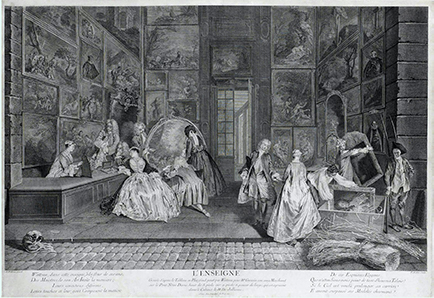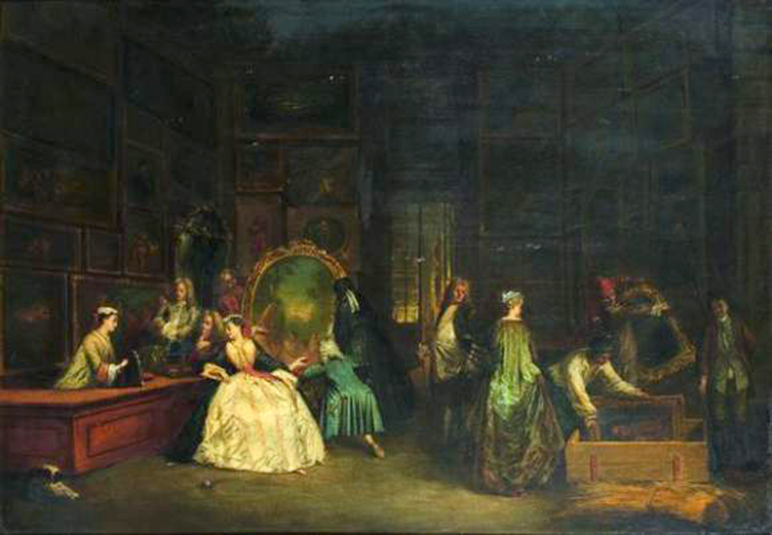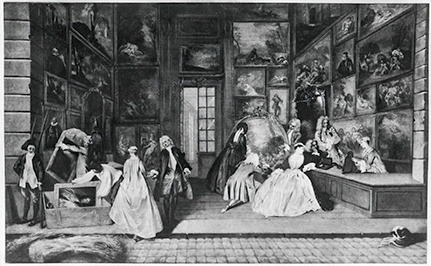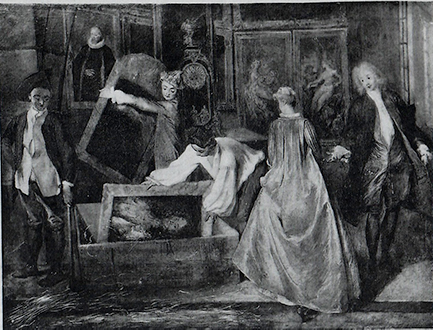
- Home Page
- Accepted
Paintings & Copies - Doubtful
Attributions - Doubtful Textual References
- Alternative
Titles - Collectors &
Museums - Bibliography
- Search Abecedario
- Watteau &
His Circle
L’Enseigne de Gersaint (copy 1)
Entered October 2020
Geneva, private collection
Oil on canvas
50.8 x 83.2 cm
RELATED PRINTS

Pierre Aveline after Pater’s copy of Watteau’s L’Enseigne de Gersaint, 1732, engraving.
When Aveline’s engraving was announced in the March 1732 issue of the Mercure galante, p. 550, it was described as being engraved after the signboard that Watteau had painted for Gersaint. This statement is misleading because, in fact, Aveline worked not from Watteau’s painting but from this reduced copy, possibly by Pater, which was one third the size of Watteau’s actual signboard. The engraving is essentially the same size as the copy.
One of the curious differences between this copy and Watteau’s painting in Berlin is that the portrait being placed in the crate is no longer identifiable as Louis XIV. This difference is repeated in Aveline’s engraving.
PROVENANCE
Châteauneuf-sur-Loire, collection of Benoît Lebrun (1754-1819; politician and architect). The painting was owned by Lebrun c. 1794, according to the 1956 Orangerie exhibition catalogue, which fails to explain what this date refers to.
Collection Saint-Gilles until 1866.Paris, collection of comte Charles Pillet-Will, 1874.
Paris, collection of Eugène Secrétan (1836-1899; industrialist). His sale, Paris, July 1, 1889, lot 150: “PATER (JEAN-BAPTISTE-JOSEPH) . . . D’APRÈS WATTEAU . . . L’Enseigne de Gersain [sic] Composition connue par la gravure de P. Aveline. Des dames et des seigneurs sont réunis chez un marchand dont la boutique est garnie de tableaux. A gauche, une dame et un gentilhomme regardant des emballeurs retirant d’une caisse un portrait de Louis XIV pendant que d’autres personnages admirent un tableau, de forme ovale, représentant des baigneuses. Charmant tableau, d’une exécution fine et spirituelle, d’un ton clair et d’une conservation parfait. Toile. Haut. 51 cent. : Larg. 83.” Sold for 20,000 francs to Edgar Stern.
Paris, collection of Edgar-Salomon Stern (1854-1937; banker) and Marguerite-Louise-Delphine Fould Stern (1870-1956).
EXHIBITIONS
Paris, Alsaciens et Lorrains (1874), cat. 960.
Paris, Musée des arts décoratifs, 1880. Lent by Charles Pillet.
Amsterdam, Exposition retrospective d’art français (1926), cat. 84 (as Pater, Copie de L‘Enseigne de Gersaint de Watteau, lent by Mme. Edgar Stern).
Paris, Orangerie, Cabinet de l’amateur (1956), cat. 84 (as Pater, L’Enseigne de Gersaint, without indication of ownership).
Paris, Musée de la Monnaie, Pèlerinage, cat. 209 (as Pater, L’Enseigne de Gersaint, lent by a private collector, Geneva).
SELECT BIBLIOGRAPHY
Bourcaud, Dessins, gouaches, estampes (1893), 526-27.
Phillips, Watteau (1895), 81 n. 1.
Laban, “Bemerkungen zum Hauptbilde Watteaus” (1900), 57-58.
Vauxcelles, “L’Enseigne de Gersaint” (1909), 209-18.
Seidel, “Das Firmenschild des Gersaint” (1910), 55-58.
Zimmerman, Watteau (1912), under no. 108.
Alfassa, “A Propos d’un livre récent” (1913), 352.
Dacier, La Gravure de genre (1925), 59.
Dacier, Vuaflart, and Hérold, Jean de Jullienne et les graveurs (1921-29), under cat 115.
Réau, “Watteau” (1928), under cat. 182.
Ingersoll-Smouse, Pater (1928), cat. 598.
Réau, “Le Premier état” (1931), 61.
Paris, Palais national, Chefs-d’oeuvre (1937), under cat. 237.
Adhémar, Watteau (1950), under cat. 215, 256.
Berlin, Museum Dahlem, Meisterwerke (1951), under cat. 136.
Paris, Petit Palais, Chefs-d’oeuvre (1951), under cat. 59.
Van Heule, “L'Enseigne de Gersaint” (1955).
Munich, Residenz, Europäische Rokoko (1958), under cat. 222.
Berlin, Charlottenburg, Meisterwerke aus den Schlösserne Friederich des Grossen (1962), under cat. 99.
Paris, Louvre, Peinture française à la cour de Fréderic II (1963), under cat. 39.
Macchia and Montagni, L’opera completa di Watteau (1968), under cat. 212.
REMARKS
This copy of Watteau’s signboard was evidently painted after late 1720 since it shows the sign in its modified second state, after the canvas was returned to a rectangle. If it was specifically commissioned to aid Aveline in engraving the composition, then it must have been painted c. 1731. But if it was commissioned by one of Watteau’s admirers who knew that he could not possess the original, then it might have been painted at any point between 1721 and 1731. The execution of some of the figures, such as the man standing outside the shop at the left, support the widely held belief that Pater was responsible for this copy. Watteau’s biographers are vague about the date when he felt remorse for having mistreated the young Pater during his apprenticeship, but given that Watteau was in England in 1719-20, it seems most likely that he did not call for Pater until his return to Paris in mid-1720.
Although it may be unsettling to discover that Jullienne did not have Aveline engrave the original signboard, there are other such instances of these sleights of hand. When it came to engraving L’Îe de Cythère, Aveline was hired to reproduce the Heughel version of the composition. As I have shown elsewhere, the original version, now in Frankfurt, was engraved by Philippe Mercier. Why this occurred is unclear. Had Mercier already taken the original Watteau painting to London? Or was the distinction between original and replica not as meaningful as it is today?
L’Enseigne de Gersaint (copy 2)
Entered October 2020; revised May 2022
Whereabouts unknown
Oil on canvas
98 x 130 cm
ALTERNATIVE TITLES
L’Enseigne
PROVENANCE
Paris, collection of Jean-Baptiste Guillaume, abbé de Gevigney (1729-1802; Généalogiste au service du comte de Provence, Garde des titres et généalogies de la Bibliothèque du Roi). His sale, Paris, May 18 ff, 1769, lot 209: “Un Tableau sur toile par le même [Vateau], qui formoit un des côtés du Tableau de Gersaint, représentant un Peintre qui fait encaisser des Tableaux, h. 36, l. 48.” Sold for 190 livres, 19 sous, according to an annotated copy of the sale catalogue in the Bibliothèque nationale, Paris.
Paris, collection of Jules Robert Auguste (1789-1869; painter and sculptor). His sale, Paris, May 28-31, 1850, lot 62: “DU MEME [WATTEAU] . . . La moitié de l’Enseigne. Tableau en plafond, fait pour son ami Gersaint, marchand sur le pont Notre-Dame. Avec sa Gravure.” Sold to baron de Schwiter according to the 1925 Michel-Lévy sale catalogue.
Paris, collection of baron Louis-Auguste de Schwiter (1805-1889; artist). His sale, Paris, Hôtel Drouot, May 3, 1886, lot 46: “WATTEAU (ANTOINE) . . . L’Enseigne. On lit dans le catalogue du Louvre, par M. Fred. Villot, édition de 1853. Édition française, page 415: «En 1720, Watteau fit un voyage en Angleterre; mais le climat de Londres étant contraire à la délicatesse de sa poitrine, il revint à Paris en 1721. Il débuta à son retour par peindre une enseigne pour la boutique de Gersaint, son ami, marchand de tableaux. Cette composition terminée en huit journées, et dont toutes les figures avaient été faites d’après nature, eut un succès prodigeux. Elle passe dans le cabinet de M. de Jullienne, autre ami de Watteau. Maintenant, un fragment se trouve sans la possession de M. le baron de Schwiter, on ignore le sort de la deuxième moitié.»
La gravure nous montre cette composition divisée en deux groups; le nôtre, qui est celui de droite, représente une jeune dame vue de dos causent avec un gentilhomme et regardant des emballeurs mettre des tableaux dans une caisse.
La gravure, par Aveline, porte les vers suivants . . .
Toile. Haut., 95 cent.; Larg., 1 m. 30 cent.”
Sold for 8,700 francs to Michel-Lévy according to an annotated copy of the sale catalogue in the Bibliothèque nationale.Paris, collection of Léon Michel-Lévy (1846-1925; banker). His sale, Paris, June 17-18, 1925, lot 159: “WATTEAU (ANTOINE) . . . L’Enseigne . . . Ce tableau est la partie gauche de la composition connue sous le titre de l’ENSEIGNE DE GERSAINT . . . On a rarement autant écrit au sujet d’un tableau. La qualité même de l’oeuvre en cause en est l’explication. Un tel litige n’aurait pu se prolonoger longtemps si les admirables peintures qui l’ont provoqué et entretenu n’étaient pas dignes de susciter la passion. Il ne saurait nous venir à la pensée de contester l’authenticité des tableaux de Berlin, mais il ne nous paraît pas non plus, actuellement, qu’une autre main que celle d’Antoine Watteau ait pu peindre la présente Enseigne. Il y a d’autres exemples d’oeuvres répétés par le maître. . . . “ Sold for 470, 000 francs.
SELECT BIBLIOGRAPHY
Goncourt, Catalogue raisonné (1875), under cat. 95.
Dohme, “Die Ausstellung” (1883) 32 n. 1.
Vauxcelles, “L’Enseigne de Gersaint” (1909), 209-18, 307-08.Seidel, “Das Firmenschild des Gersaint” (1910), 180-86.
Zimmerman, Watteau (1912), no. 104 bis.
Dacier, Vuaflart, and Hérold, Jean de Jullienne et les graveurs (1921-29), under cat. 115.
Gillet, Watteau (1921), 184-86.
Réau, “Watteau” (1928), under cat. 182.
Réau, “Le Premier état” (1931), 61.
Paris, Palais national, Chefs-d’oeuvre (1937), under cat. 237.
Adhémar, Watteau (1950), under cat. 215.
Paris, Petit Palais, Chefs-d’oeuvre (1951), under cat. 59.
Van Heule, “L'Enseigne de Gersaint” (1955), 604, 606.
Munich, Residenz, Europäische Rokoko (1958), under cat. 22.
Macchia and Montagni, L’opera completa di Watteau (1968), under cat. 212.
Macchia and Montagni, L’opera completa di Watteau (1968), under cat. 212.
Paris, Louvre, Peinture française (1968), under cat. 39.
Roland Michel, Watteau (1984), 302.
REMARKS
The large size of this picture establishes that it was copied from Watteau’s original signboard and not from Pater’s copy (our copy 1). Although it is only about two thirds the height of Watteau’s original, this copy essentially matches the scale of the painting in Berlin.
Throughout the late nineteenth and early twentieth centuries many scholars, particularly French ones, favored this picture’s attribution to Watteau. But gradually, as the Kaiser’s version became known outside of Berlin, opinion shifted away from the French candidate.
It is possible that this picture figured in the 1850 sale of the Auguste collection. But that sale catalogue states only that half the Gersaint signboard was at auction, without defining whether it was the right or left half. Thus we cannot be certain if this was Auguste’s, formerly owned by the abbé de Gévigney or its pendant (our copy 3).
L’Enseigne de Gersaint (copy 3)
Entered October 2020; revised December 2020

Whereabouts unknown
Probably oil on canvas
Probably 98 x 130 cm
ALTERNATIVE TITLES
Une salle d’un marchand de tableaux
PROVENANCE
Paris, collection of Monsieur Francillon. His sale, Paris, May 12 ff, 1829, lot 157: “WATTEAU (ANTOINE) . . . . Dans une salle d’un marchand de tableaux. Dans une salle ornée de peintures, une jeune femme assise à son comptoir , présente à une dame un petit tableau que celle-ci régarde avec beaucoup d’attention. Un autre tableau posé à terre occupe particulièrement les regards de plusieurs amateurs, dont l’un s’est agenouillé pour le mieux voir. Nous avons entendu dire que cet ouvrage fut fait pour Gersaint, et servait d’enseigne à son magasin.”
SELECT BIBLIOGRAPHY
Vauxcelles, “L’Enseigne de Gersaint” (1909), 210-11.
Dacier, Vuaflart, and Hérold, Jean de Jullienne et les graveurs (1921-29), under cat. 115.
Réau, “Watteau” (1928), under cat. 182.
Paris, Palais national, Chefs-d’oeuvre (1937), under cat. 237.
Adhémar, Watteau (1950), under cat. 215.
Van Heule, “L'Enseigne de Gersaint” (1955), 604.
Paris, Petit Palais, Chefs-d’oeuvre de Berlin (1951), under cat. 59.
Munich, Residenz, Europäisches Rokoko (1958), under cat. 222.
Paris, Louvre, Peinture française (1963), under cat. 39.
Macchia and Montagni, L’opera completa di Watteau (1968), under cat. 212.
REMARKS
The 1829 description of the painting shows that it was a copy of the right-hand section of L’Enseigne de Gersaint. It undoubtedly was a pendant to the copy of the left-hand portion of L’Enseigne (our copy 2). Therefore we have assumed that it had the same measurements as the still extant pendant.
It is possible that this picture figured in the 1850 sale of the Auguste collection. The catalogue of that sale states that half of the Gersaint signboard was being sold, but it does not define whether it was the right or the left half of Watteau’s composition. However, it is generally assumed that it was the left half, i.e., the portion that later was in the Schwiter and Michel-Lévy collections (our copy 2).
L’Enseigne de Gersaint (copy 4)
Entered October 2020

Whereabouts unknown
Medium unknown
28 x 41.9 cm
PROVENANCE
Sale, London, Christie’s, March 8, 1902, lot 124: “WATTEAU (AFTER) . . . L’ENSEIGNE DE GERSAINT / 11 in. by 16½ in.” According to the Christie’s annotated copy of the catalogue, now in the National Arts Library, Victoria & Albert Museum, the painting sold for £10.10 to Couseau.
Sale, London, Christie’s, June 4, 1923, lot 82: “WATTEAU. . . L’ENSEIGNE DE GERSAINT / 11 in. by 16½ in.” According to Christie’s annotated copy of the catalogue, now in the National Arts Library, Victoria & Albert Museum, the painting sold for £7.7 to Leger.
Sale, London, Christie’s, June 22, 1951, lot 168: “WATTEAU . . . L’ENSEIGNE DE GERSAINT—11in. by 16in.” According to the Christie’s annotated copy of the catalogue, now in the National Arts Library, Victoria & Albert Museum, the painting sold for £30 to Werner.
REMARKS
This copy of L’Enseigne, not mentioned in the Watteau literature, is evidently a small replica of Watteau’s composition, measuring only half the size of Pater’s reduction (our copy 1).
L’Enseigne de Gersaint (copy 5)
Entered October 2020; revised April 2021

Whereabouts unknown
Oil on canvas
78.5 x 106 cm
PROVENANCE
Collection of A. Philips-Neven. His sale, Maastricht, Frederick Müller & Cie, March 24-25, 1892, lot 144: “ANTOINE WATTEAU. . . . Belle copie d’une composition célèbre du Maître, représentant le magasin de tableaux de son ami Gersain, où le monde élégant fait son choix et où les assistants du marchand font l’emballage des pièces vendues. Toile.—Hauteur 78, larguer 108 cent."
Liège, collection of Madame V. Libert, c. 1950-55. Mistakenly cited by Adhémar as in Antwerp, without naming the owner.
Sale, Paris, Hôtel Drouot (Piasa), June 27, 2008, lot 96: “Ecole FRANÇAISE, vers 1860, d’après Antoine WATTEAU . . . L’enseigne de Gersaint / Toile / 78.5 x 106 cm / Restaurations / 15 000 / 18 000 € / Notre tableau est la réplique et en sens invers, d’après la gravure de la composition de Watteau conservée à Berlin, à la Gemälde Galerie.
Provenance: Vente Philips-Neven, Maastricht, 24-25 mars 1892 (Me Müller), no 144, d’après une etiquette de vente au revers du chassis.”Sale, Paris, Hôtel Drouot (Piasa), May 7, 2009, lot 26: École FRANÇAISE vers 1860, d’après Antoine WATTEAU . . . L’enseigne de Gersaint / Toile / 78,5 x 106 cm / Restaurations / 15 000 / 18 000 €
Notre tableau est la réplique en sens invers, d’après la gravure de la composition de Watteau conservé à Berlin, à la Gemälde Galerie. Provenance: Vente Philips-Neven, Maastricht, 24-25 mars 1892 (Me Müller), no 144, d’après une etiquette de vente au revers du chassis.”
EXHIBITIONS
Valenciennes, 1934 (cited by Van Heule).
SELECT BIBLIOGRAPHY
Adhémar, Watteau (1950), under cat. 215.
Van Heule, “L'Enseigne de Gersaint” (1955).
REMARKS
This copy of Watteau’s composition was evidently based on Aveline’s engraving, but its scale was increased by 50%. Van Heule’s attempted attribution to Watteau himself is unfounded.
L’Enseigne de Gersaint (copy 6)
Entered October 2020

Whereabouts unknown
Medium unknown
61 x 76.2 cm
ALTERNATIVE TITLES
L’intérieure d’une boutique d’un marchand de tableaux
PROVENANCE
Paris, collection of Anne-Emmanuel-Ferdinand-François de Croÿ, Prince of Solre and Duke of Croÿ (1743-1803), inventory drawn up after the duke fled France, c. 1790: “Autre représentant l’intérieur d’une boutique de marchand de tableaux, par Watteau, de 31 pouces de large sur 19 pouces de haut, no 6.”
SELECT BIBLIOGRAPHY
Archives de l’art français (1901), 328.
Adhémar, Watteau (1950), under cat. 215.
REMARKS
Adhémar was the first to draw attention to this reference. She proposed that this picture was the same as the copy in Antwerp [sic for Liège] (our copy 5). But that picture was substantially larger.
Click here for L'Enseigne de Gersaint

